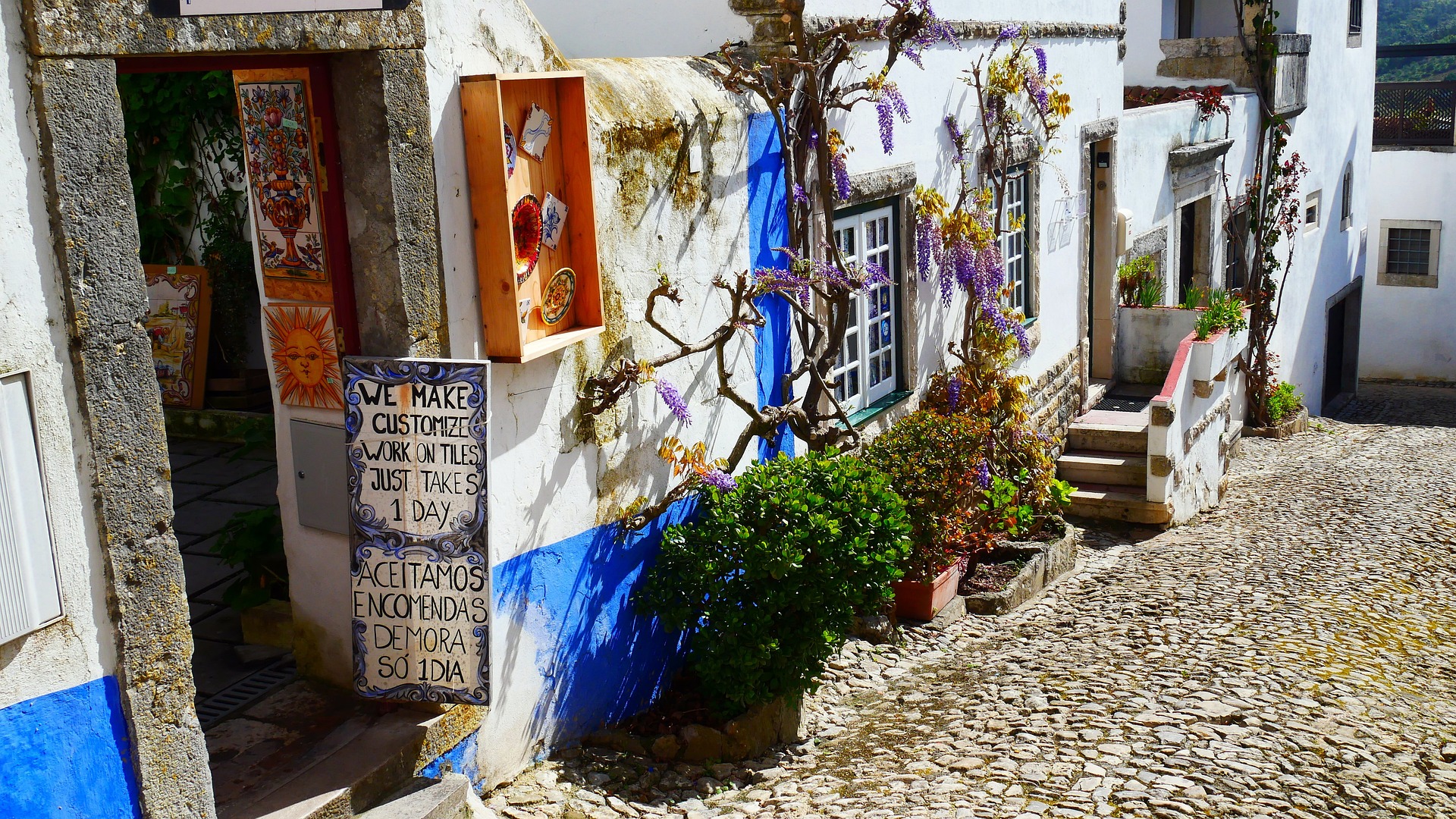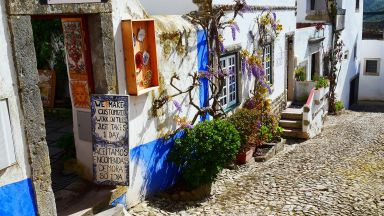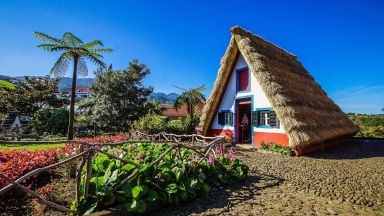Self Guided Walking tour of Óbidos (With Maps!)
This website uses affiliate links which earn a small commission at no additional cost to you.
Obidos stands out as the ultimate representation of a fortified town in Portugal and remains one of the most coveted tourist hotspots in the Lisbon area.
Historically, Obidos was under the ownership of the Queen of Portugal, a tradition that dates back to 1282 when Queen Isabel was given the town on her wedding day. This royal legacy has left a remarkable mark on Obidos, making it the most captivating and alluring town in central Portugal.
While exploring Obidos, visitors will be immersed in the beauty of traditional houses, charming cobblestone streets, and an impressive medieval castle. Although the town itself is small and can be fully explored in a few hours, it promises to be a delightful experience.
The surrounding region of Obidos is equally enchanting, with attractions like the fishing town of Peniche, the unspoiled beaches of Lagoa de Obidos, and Europe’s largest collection of Buddha statues at Buddha Eden. Obidos provides an excellent base from which to discover this captivating region, and it has become a highly sought-after vacation destination.
Where to Park when visiting Óbidos?
There are a couple of free car parks to the south of the old town.
Aqueduto de Óbidos

The first site crosses directly behind the carpark.
The Aqueduto de Óbidos, also known as the Aqueduct of Santa Maria, was built in the 16th century to supply water to the town and its castle. The aqueduct is an impressive feat of engineering, with a length of over three kilometers and a height of up to 30 meters in some places. It was built using a combination of stone and brick, and features 34 arches that span across the valley below.
Today, the Aqueduto de Óbidos is a popular tourist attraction and an important landmark of the town. Visitors can walk along the top of the aqueduct and enjoy views of the surrounding countryside, or explore the historic town of Óbidos and its many other attractions.
Location: Aqueduto de Óbidos, N114, Óbidos, Portugal
Read more about Aqueduto de Óbidos
Porta da Vila

Leave the car park and walk along the R. da Porta da Vila with the white wall on your left. Pass the Óbidos Parish Art Museum and you will come to the Porta da Vila (Óbidos)
The primary gateway to the village of Óbidos is known as Porta da Vila. This double gate boasts an interior adorned with 18th-century tiles and leads visitors directly to Rua Direita, the village’s main street. Above the entrance, you’ll find an inscription that reads “The Virgin Our Lady was conceived without original sin.”
King D. João IV ordered the construction of this gate as a gesture of gratitude for patronal protection during the restoration of independence in 1640. The gate’s interior houses the chapel-sanctuary of Nossa Senhora da Piedade, the village’s patron saint. The baroque veranda and blue and white tiles within the chapel date back to the mid-1740s and 1750s and feature an allegorical representation of the passion of Christ.
Location: Porta da Vila, Rua Josefa de Óbidos, Óbidos, Portugal | Hours: 24 Hours | Price: Free
Read more about Porta da Vila (Óbidos)
Obidos castle

As you pass through the arch bear left and you can walk up the steps to walk along the walls (Muralha de Óbidos). Walk anticlockwise around them. Half way up you will pass over the Porta do Vale ou Senhora da Graça, the second largest gate, it has an image of Nª Senhora da Graça, adorned with sacred art around it.
Obidos castle has a long history, with construction dating back to the mid 1st century during the Roman era. However, it was only completed during the occupation by the Moors. In 1148, the fortress was conquered by the first king of Portugal, Dom Afonso Henriques, who also took control of the village. Later in 1210, the town of Obidos was gifted to Queen Urraca by King Afonso II, and from then on, it became a favored location of the Queens of Portugal. As a result, Obidos earned the nickname “Vila das Rainhas” (town of the Queens).
Location: Castelo de Óbidos, Rua Josefa de Óbidos, Óbidos, Portugal
Read more about Castelo de Óbidos
Praça de Santa Maria

Leave the walls at the castle and head along R. Direita and you will soon arrive at Praça de Santa Maria.
Praça de Santa Maria is the main square of the town. It is a picturesque and charming square with a central fountain and surrounded by colourful houses and cafes. The square is often bustling with activity and is a popular spot for tourists to relax and take in the sights and sounds of the town.
In the centre of the square is a statue of King D. Afonso Henriques, the first king of Portugal, who conquered the town from the Moors in the 12th century. The statue is a popular spot for taking photos.
The church facing the square is the Igreja de Santa Maria, a small church largely rebuilt in the 1600s, with a painted wooden ceiling & a notable carved tomb.
Location: Praça de Santa Maria, Óbidos, Portugal
Read more about Praça de Santa Maria (Óbidos)
Municipal Museum of Óbidos

The large building to the south of the square is the Municipal Museum of Óbidos.
The Municipal Museum of Óbidos is housed in a former 16th-century mansion. The museum aims to preserve and promote the cultural heritage of Óbidos and the surrounding region.
The museum has a collection of archaeological artefacts, including Roman and medieval ceramics, as well as historical documents and works of art. Among the highlights of the museum’s collection are the 17th-century paintings of Josefa de Óbidos, one of the most important Baroque artists in Portugal, who was born in the town.
The museum is divided into several thematic areas, including the history of Óbidos, the role of the town in the Portuguese Restoration War, and the traditions and customs of the region. There are also temporary exhibitions that focus on various aspects of local culture, such as traditional handicrafts and folk art.
Visitors to the museum can also explore the building itself, which has been restored to its former glory, with its ornate ceilings and decorative tiles. There is also a garden with a small pond and a well, which provides a peaceful oasis in the heart of the town.
Location: Museu Municipal de Óbidos, Rua Direita, Óbidos, Portugal | Hours: 10am-1pm & 2-6pm Tue-Sun
Read more about Museu Municipal de Óbidos
Carry on heading south along the R. Direita until you reach the Porta da Vila again.
This website uses affiliate links which earn a small commission at no additional cost to you.



